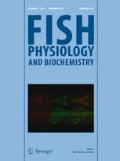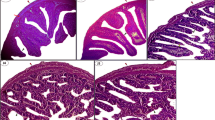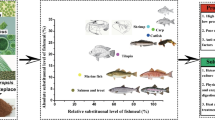Abstract
An 8-week feeding trial was conducted to evaluate the effects of dietary supplementation with green tea waste (GTW) on growth, digestive enzyme and lipid metabolism of juvenile hybrid tilapia, Oreochromis niloticus × O. aureus. The fish (initial mean body weight, 12.63 ± 0.75 g) were fed five experimental diets that included 0 (control), 0.8, 1.6, 3.2 or 6.4 % of GTW in triplicate aquaria, twice daily. Growth performance, plasma metabolites content and liver and intestine digestive enzyme activities were determined. Fish accepted well all experimental diets during the trial, and no mortality was observed. The weight gain increased (P < 0.05) with the increase in GTW inclusion level up to 1.6 %, after which it decreased, but no significant differences between the control and high level (3.2 or 6.4 % of GTW) groups were observed. Moreover, fish fed on diets containing 0.8 and 1.6 % GTW had lower feed conversion ratio (FCR, 1.75 and 1.73, respectively) and had better protein deposition (higher protein efficiency ratio, PER, 1.73 and 1.71, respectively), compared to other treatments. No differences among groups were observed in whole body and dorsal muscle composition with the exception of lipid content which was lower in fish fed 6.4 % GTW diets, compared to other treatments. Lipase activities in liver or intestine were higher in fish fed GTW-supplemented diets with the exception of intestine lipase activities, which was unaffected, compared to the control. Similarly, liver lipoprotein lipase activities were also increased in fish fed diets supplemented a medium dose of GTW (1.6 or 3.2 %), compared to other treatments. However, intestine amylase activities were decreased in fish fed diets containing a high dose of GTW (3.2 and 6.4 %); while the liver amylase activities were unaffected by the GTW supplementation. Blood chemistry parameters were affected by GTW inclusion, except the values of triglycerides, which was unaffected. The values of total cholesterol, HDL cholesterol and LDL cholesterol increased with increasing GTW inclusion level up to 3.2 %, after which the values decreased. These results indicate that diets supplemented with appropriate concentration of GTW (from 0.8 to 1.6 %) may potentially serve as an effective functional food and additive for tilapia to improve growth performance, digestion efficacy and fat metabolism.
Similar content being viewed by others
References
Abdel-Tawwab M, Ahmad MH, Seden MEA, Sakr SFM (2010) Use of green tea, Camellia sinensis L., in practical diet for growth and protection of Nile tilapia, Oreochromis niloticus (L.), against Aeromonas hydrophila infection. J World Aquac Soc 41:203–213
Afsharmanesh M, Sadaghi B (2014) Effects of dietary alternatives (probiotic, green tea powder, and Kombucha tea) as antimicrobial growth promoters on growth, ileal nutrient digestibility, blood parameters, and immune response of broiler chickens. Comp Clin Pathol 23:717–724
Ahmed ST, Lee JW, Mun HS, Yang CJ (2014) Effects of supplementation with green tea by-products on growth performance, meat quality, blood metabolites and immune cell proliferation in goats. J Anim Physiol Anim Nutr 99:1127–1137
Axling U, Olsson C, Xu J, Fernandez C, Larsson S, Ström K, Ahrné S, Holm C, Molin G, Berger K (2012) Green tea powder and Lactobacillus plantarum affect gut microbiota, lipid metabolism and inflammation in high-fat fed C57BL/6 J mice. Nutr Metab (Lond) 9:105
Boran H, Cengiz Çiftci C, Er A, Köse Ö, Kurtoğlu İZ, Ka Ş (2015) Evaluation of antibacterial activity of green tea (Camellia sinensis L.) seeds against some fish pathogens in rainbow trout (Oncorhynchus mykiss, Walbaum). Turkish J Fisheries and Aquatic Sci 15:49–57
Bose M, Lambert JD, Ju J, Reuhl KR, Shapses SA, Yang CS (2008) The major green tea polyphenol, (−)-Epigallocatechin-3-Gallate, inhibits obesity, metabolic syndrome, and fatty liver disease in high-fat-fed mice. J Nutr 138:1677–1683
Cabrera C, Giménez R, López MC (2003) Determination of tea components with antioxidant activity. J Agric Food Chem 51:4427–4435
Cabrera C, Artacho R, Giménez R (2006) Beneficial effects of green tea—a review. J Am College Nutr 25:79–99
Cao H, Hininger-Favier I, Kelly MA, Benaraba R, Dawson HD, Coves S, Roussel AM, Anderson RA (2007) Green tea polyphenol extract regulates the expression of genes involved in glucose uptake and insulin signaling in rats fed a high fructose diet. J Agric Food Chem 55:6372–6378
Chen N, Bezzina R, Hinch E, Lewandowski PA, Cameron-Smith D, Mathai ML, Jois M, Sinclair AJ, Begg DP, Wark JD, Weisinger HS, Weisinger RS (2009) Green tea, black tea, and epigallocatechin modify body composition, improve glucose tolerance, and differentially alter metabolic gene expression in rats fed a high-fat diet. Nutr Res 29:784–793
Cho SH, Kim C (2009) Effect of dietary inclusion of various sources of additives on growth and body composition of juvenile olive flounder Paralichthys olivaceus. Aquac Res 40:625–629
Cho SH, Lee SM, Park BH, Ji SC, Lee J, Bae J, Oh SY (2007) Effect of dietary inclusion of various sources of green tea on growth, body composition and blood chemistry of the juvenile olive flounder, Paralichthys olivaceus. Fish Physiol Biochem 33:49–57
Cunha CA, Lira FS, Rosa Neto JC, Pimentel GD, Souza GI, da Silva CM, de Souza CT, Ribeiro EB, Sawaya AC, Oller do Nascimento CM, Rodrigues B, de Oliveira Carvalho P, Oyama LM (2013) Green tea extract supplementation induces the lipolytic pathway, attenuates obesity, and reduces low-grade inflammation in mice fed a high-fat diet. Mediators Inflamm 2013:35470–635470
De Silva S, Subasinghe R, Bartley D, Lowther A (2004) Tilapias as alien aquatics in Asia and the Pacific: a review. FAO Fisheries Technical Paper 453
FAO The state of World fisheries and aquaculture (2016) Food and Agriculture Organization of the United Nations, Rome
Guo YJ, Zhang DF, Fan HP (2012) Molecular epidemiology of Streptococcus agalactiae isolated from tilapia in Southern China. J Fish China 36:399–406
He Q, Lv YP, Yao K (2007) Effects of tea polyphenols on the activities of α-amylase, pepsin, trypsin and lipase. Food Chem 101:1178–1182
Heber D, Zhang Y, Yang J, Ma JE, Henning SM, Li Z (2014) Green tea, black tea, and oolong tea polyphenols reduce visceral fat and inflammation in mice fed high-fat, high-sucrose obesogenic diets. J Nutr 144:1385–1393
Hwang JH, Lee SW, Rha SJ, Yoon HS, Park ES, Han KH, Kim SJ (2013) Dietary green tea extract improves growth performance, body composition, and stress recovery in the juvenile black rockfish, Sebastes schlegeli. Aquac Int 21:525–538
Ji SC, Takaoka O, Jeong GS, Lee SW, Ishimaru K, Seoka M, Takii K (2007) Dietary medicinal herbs improve growth and some non-specific immunity of red sea bream Pagrus major. Fish Sci 73:63–69
Kaneko K, Yamasaki K, Tagawa Y, Tokunaga M, Tobisa M, Furuse M (2000) Effects of Japanese tea (green tea) on the growth and fat deposition of the broiler. Jpn Poult Sci 37:349–356
Kaneko K, Yamasaki K, Tagawa Y, Tokunaga M, Tobisa M, Furuse M (2001) Effects of dietary Japanese green tea powder on growth, meat ingredient and lipid accumulation in broilers. Jpn Poult Sci 38:77–85
Kaneko K, Hazama H, Kawahara S, Tobisa M, Furuse M, Muguruma M (2005) Effects of dietary used green tea powder on meat ingredient and suppression of lipid oxidation in broilers. Jpn Poult Sci 42:159–164
Kao YH, Hsin-Huei Chang MJL, Chen CL (2006) Tea, obesity, and diabetes. Mol Nutr Food Res 50:188–210
Khan SA, Priyamvada S, Arivarasu NA, Khan S, Yusufi AN (2007) Influence of green tea on enzymes of carbohydrate metabolism, antioxidant defense, and plasma membrane in rat tissues. Nutrition 23:687–695
Kim KT, Jeon GH, Cho SH, Lim SG, Kwon MG, Yoo JH (2013) Effects of dietary inclusion of various concentrations of Scutellaria baicalensis Georgi extract on growth, body composition, serum chemistry and challenge test of far eastern catfish (Silurus asotus). Aquac Res 44:1502–1510
Kojima S, Yoshida Y (2008) Effects of green tea powder feed supplement on performance of hens in the late stage of laying. Int J Poult Sci 5:491–496
Kono M, Furukawa K, Sagesaka YM, Nakagawa K, Fujimoto K (2000) Effect of green tea extracts and green tea grounds as dietary supplements on cultured Yellow tail and Ayu. Nipp Shok Kag Kai 47:932–937
Lim CE, Webster CD (2006) Tilapia: biology, culture, and nutrition. The Haworth Press Inc., Bringhamton
Lin HZ, Li ZJ, Chen YQ, Zheng WH, Yang K (2006) Effect of dietary traditional Chinese medicines on apparent digestibility coefficients of nutrients for white shrimp, Litopenaeus vannamei, Boone. Aquaculture 253:495–501
Lin X, Chen WY, Lin SM, Luo L (2015) Effects of dietary cecropin on growth, non-specific immunity and disease resistance of tilapia (Oreochromis niloticus × O. aureus). Aquac Res 46:2999–3007
Liu ZX, Ke H, Hao L, Ma YP, Lin M (2012) Effect of tea polyphenols on growth performance, antioxidant effect and non-specific immune indices of Oreochromis niloticus. Guangdong Agric Sci 39:113–115 (China)
Long M, Hou J, Su YJ, Wu N, Zhang WR, Sun BC, Li L (2015) Effects of selenium yeast and tea polyphenols on growth and related gene transcription in the hypothalamus-pituitary-growth axis, muscle composition and disease resistance of juvenile Wuchang bream (Megalobrama amblycephala). J Fish China 39:97–107
Meguro S, Hasumura T, Hase T (2015) Body fat accumulation in zebrafish is induced by a diet rich in fat and reduced by supplementation with green tea extract. PLoS ONE 10:e0120142
Nie SP, Xie MY (2011) A review on the isolation and structure of tea polysaccharides and their bioactivities. Food Hydrocolloid 25:144–149
Nootash S, Sheikhzadeh N, Baradaran B, Oushani AK, Moghadam MRM, Nofouzi K, Monfaredan A, Aghebati L, Zare F, Shabanzadeh S (2013) Green tea (Camellia sinensis) administration induces expression of immune relevant genes and biochemical parameters in rainbow trout (Oncorhynchus mykiss). Fish Shellfish Immunol 35:1916–1923
Pérez-Jiménez A, Peres H, Rubio VC, Oliva-Teles A (2012) The effect of dietary methionine and white tea on oxidative status of gilthead sea bream (Sparus aurata). Br J Nutr 108:1202–1209
Pérez-Jiménez A, Peres H, Rubio VC, Oliva-Teles A (2013) Effects of diet supplementation with white tea and methionine on lipid metabolism of gilthead sea bream juveniles (Sparus aurata). Fish Physiol Biochem 39:661–670
Qiu XC, Zhou HQ, Liu XG, Hua XM, Cao D, Zhang DL (2002) The effect of dietary Chinese herb additives on growth and digestibility of Allogynogenetic crucian carp. J Fish China 26:551–555
Qiu XC, Zhou HQ, Hua XM, Liu XG, Cao D (2004) The effect of dietary Chinese additives on digestibility of Allogynogenetic crucian carp. J Xinyang Normal Univ (Nat Sci Ed) (China) 17:54–56
Raederstorff DG, Schlachter MF, Elste V, Weber P (2003) Effect of EGCG on lipid absorption and plasma lipid levels in rats. J Nutr Biochem 14:326–332
Sajilata MG, Bajaj PR, Singhal RS (2008) Tea polyphenols as nutraceuticals. Compr Rev Food Sci Food Saf 7:229–254
Saraee MHA, Seidavi A, Dadashbeiki M, Laudadio V, Tufarelli V (2014) Effect of dietary supplementation with different levels of green tea powder and fish oil or their combination on carcass characteristics in broiler chickens. Pak J Zool 46:1767–1773
Sheikhzadeh N, Nofouzi K, Delazar A, Oushani AK (2011) Immunomodulatory effects of decaffeinated green tea (Camellia sinensis) on the immune system of rainbow trout (Oncorhynchus mykiss). Fish Shellfish Immunol 31:1268–1269
Shen CL, Han J, Wang S, Chungd E, Chyua MC, Cao JJ (2015) Green tea supplementation benefits body composition and improves bone properties in obese female rats fed with high-fat diet and caloric restricted diet. Nutr Res 35:1095–1105
Shi QY, Schlegel V (2012) Green tea as an agricultural based health promoting food: the past five to ten years. Agriculture 2:393–413
Soosean C, Marimuthu K, Sudhakaran S, Xavier R (2010) Effect of mangosteen (Garcinia mangostana L.)extracts as a feed additive on growth and hematological parameters of African catfish (Clarias gariepinus) fingerlings. Eur Rev Med Pharmacol Sci 14:605–611
Thawonsuwan J, Kiron V, Satoh S, Panigrahi A, Verlhac V (2010) Epigallocatechin-3-gallate (EGCG) affects the antioxidant and immune defense of the rainbow trout, Oncorhynchus mykiss. Fish Physiol Biochem 36:687–697
Wang JQ, Sun YX, Zhang JC (2006) Effects of Chinese herb additives on growth, digestive activity and non- specific immunity in flounder Paralichthys olivaceus. J Fish China 30:90–96
Wu XL, Wang WP, Zhu T, Liang T, Lu FQ, He WY, Zhang HP, Liu ZG, He SH, Gao KP, He ZD (2013) Phenylpropanoid glycoside inhibition of pepsin, trypsin and α-chymotrypsin enzyme activity in Kudingcha leaves from Ligustrum purpurascens. Food Res Int 54:1376–1382
Zhang YBP, Zhou YB, Sang BY, Wan XC (2015) Effect of dietary Chinese tea on growth performance, disease resistance and muscle fatty acid profile of channel catfish (Ictalurus punctatus). Aquacult Int 23:683–698
Zheng QM, Chen KP, Zhong YM, Zhang ZY, Zheng JL (2015) Determination and analysis of main components of four kinds of tea and their tea wastes. Guangdong Agric Sci 42:14–20 (China)
Zhou XL, Wang DF, Sun PN (2007) Effects of soluble tea polysaccharides on hyperglycemia in alloxan-diabetic mice. J Agric Food Chem 55:5523–5528
Acknowledgments
This work was supported by Project of Training Outstanding Young Teachers in Higher Education Institutions in Guangdong Province (Yq2013152) (China); Natural Science Foundation of Guangdong Province (S2013010013693) (China); Science and Technology Project of Guangdong Province (2013B020307016) (China). Authors are appreciating associate professor Giovanni M. Turchini in School of Life and Environmental Sciences, Deakin University, Australia, for his keen English revision in this work.
Author information
Authors and Affiliations
Corresponding author
Rights and permissions
About this article
Cite this article
Zheng, Q., Han, C., Zhong, Y. et al. Effects of dietary supplementation with green tea waste on growth, digestive enzyme and lipid metabolism of juvenile hybrid tilapia, Oreochromis niloticus × O. aureus . Fish Physiol Biochem 43, 361–371 (2017). https://doi.org/10.1007/s10695-016-0292-5
Received:
Accepted:
Published:
Issue Date:
DOI: https://doi.org/10.1007/s10695-016-0292-5




